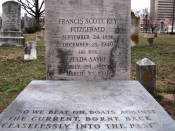COLORS OF THE GREAT GATSBY American Studies By Josh Marshall Great artists use many colors and shades to portray emotions and ideas. They use bright strong colors to give the feeling of warmth and happiness, and dark grayish colors to give the feeling of death and sadness. In the novel The Great Gatsby, F. Scott Fitzgerald is the artist. He uses colors such as white, blue, and green to symbolize many different ideas and emotions in the book.
The very first color used in The Great Gatsby is white. Fitzgerald used this color in one of the opening scenes at the Buchanan household. Daisy and Jordan are both clothed in gorgeous white summer dresses, lying on white couches, and in a white room. The white color in this novel symbolizes innocence, purity, and beauty. This is before their true identity is revealed. It turns out that neither of these women are any of those things.
They are both fake. The women use white clothes to hide the fact that they were not sweet little girls, but corrupt fakes putting on an act. Fitzgerald had another symbolic meaning in the color white. It was that white is the easiest color to soil or tarnish. It tells you how the beautiful, innocent women quickly change and become corrupted as the book goes on. In the first chapter it says, "They were both in white, and their dresses were rippling and fluttering as if they had just been blown back in after a short flight around the house"ÃÂ(8). This implies that they are something beautiful and perfect such as angels or doves. But soon, the reader finds that these doves are truly crows painted white.
The next color Fitzgerald used was blue. Blue is a color that traditionally represents a fantasy, dream, or another world. There are two great examples of this in The Great Gatsby, the first of which is Gatsby's mansion. Gatsby was not raised with wealth and did not have a boyhood home like the one he purchased in West Egg. The struggling middle class and the wealthy are two very different worlds. In the eyes of a young Jay Gatsby, a mansion in West Egg Manhattan would be only thought of in his dreams. Only in Gatsby's wildest fantasies would his mansion be possible. That is exactly why Gatsby's lawn and mansion are portrayed in blue. The second example of blue symbolizing another world is T. J. Eckleburg's eyes. They were in the valley of ashes on an old billboard. Wilson spoke of Eckleburg's eyes as god. "God knows what you've been doing, everything you've been doing. You may fool me, but you can't fool god"ÃÂ(160) Wilson was referring to the blue eyes watching over the valley of ashes from another world. He considered them to be god's eyes looking down from heaven. This is another example of blue symbolizing another world.
Last is the color green. The color green was used throughout the book to symbolize Gatsby's dream and wealth. At one point in the novel Gatsby is staring across the bay. All he can see is a green light. This light is at the end of Daisy's dock. It is symbolizing Daisy and everything he has worked for. All the money he has earned to get her and how close he is to getting her. At the very end of The Great Gatsby Nick talks about Gatsby's dream and brings up the green light.
"æI thought of Gatsby's wonder when he first picked out the green light at the end of Daisy's dock. He had come along way to this blue lawn, and his dream must have seemed so close that he could hardly fail to grasp it.
(182) When Gatsby looked at the green light all he saw was Daisy. She was everything he worked for and the only thing he wanted.
Artists use color to paint pictures and show emotions. F. Scott Fitzgerald used this same technique, but his pictures were painted in your mind. He used colors such as green, white, and blue to symbolize ideas and feelings such as: purity, innocence, beauty, ambition, and fantasy. All of these symbols give you a better feeling about the novel and the message the author was trying to portray. Paintings show you a picture, but the symbolic colors and words in The Great Gatsby let your mind do the painting.





